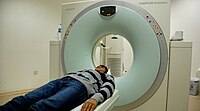
Photo from wikipedia
Background It is unknown how many distressed patients receive the additional supportive care recommended by Australian evidence-based distress management guidelines. The study identifies the (1) distress screening practices of Australian… Click to show full abstract
Background It is unknown how many distressed patients receive the additional supportive care recommended by Australian evidence-based distress management guidelines. The study identifies the (1) distress screening practices of Australian cancer services; (2) barriers to improving practices; and (3) implementation strategies which are acceptable to service representatives interested in improving screening practices. Method Clinic leads from 220 cancer services were asked to nominate an individual involved in daily patient care to complete a cross-sectional survey on behalf of the service. Questions related to service characteristics; screening and management processes; and implementation barriers. Respondents indicated which implementation strategies were suitable for their health service. Results A total of 122 representatives participated from 83 services (51%). The majority of respondents were specialist nurses or unit managers (60%). Approximately 38% of representatives’ services never or rarely screen; 52% who screen do so for all patients; 55% use clinical interviewing only; and 34% follow referral protocols. The most common perceived barriers were resources to action screening results (74%); lack of time (67%); and lack of staff training (66%). Approximately 65% of representatives were interested in improving practices. Of the 8 implementation strategies, workshops (85%) and educational materials (69%) were commonly selected. Over half (59%) indicated a multicomponent implementation program was preferable. Conclusions Although critical gaps across all guideline components were reported, there is a broad support for screening and willingness to improve. Potential improvements include additional services to manage problems identified by screening, more staff time for screening, additional staff training, and use of patient-report measures.
Journal Title: Supportive Care in Cancer
Year Published: 2019
Link to full text (if available)
Share on Social Media: Sign Up to like & get
recommendations!